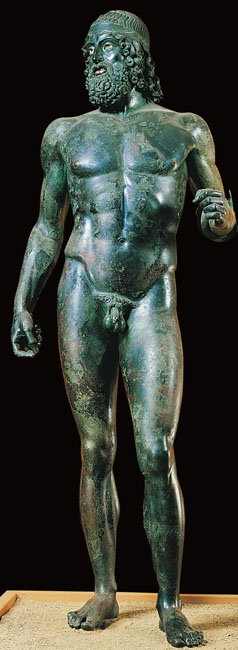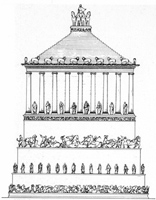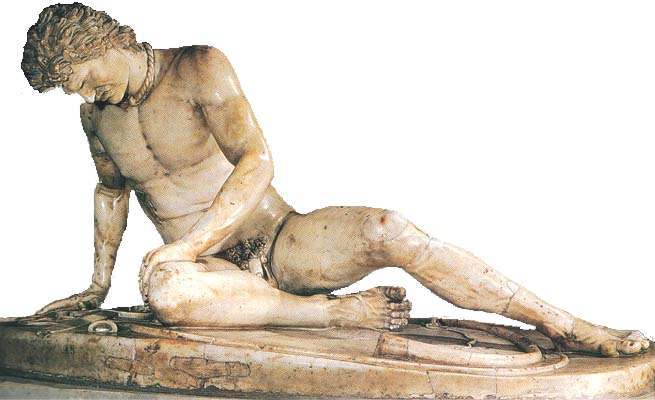|
reconstruction drawing of the east pediment of the temple of aphaia, aegina |
|
-Greek-depicts 1st sack of Troy-the elevation of historical events to a universal plane through allegory was typical of Greek art-goddess Athena in the middle --> Greeks & Trojana on either side-poses are in symmetrical arrangement -- balanced design-way the designer filled the awkward shape of a temple pediment |
| |

|
|
-Dying warrior from the west pediment of the Temple of Aphaia, 500-490 BCE, GREEK
-much less natural than the dying warrior of the east pediment (480 bce)-head-on stare at viewer-smiling yields to the suffering of a warrior in his final moments - not as convincing |
| |

|
|
-dying warrior from the east pediment of the Temple of Aphaia, 480 BCE, GREEK
-more natural than the dying warrior from the west pediment -- shows the advance sculptors made towards naturalism during the decades that separated them-weight seems to pull him irresistibly to the ground-the body is more convincingly twisted from the waist - so that the left shoulder moves into a new plane-turns his gaze to the ground rather than head-on stare --> suggests introspection - more convincing |
| |
|
ARCHAIC PERIOD, THE CLASSICAL AGE, THE LATE CLASSICAL PERIOD, THE AGE OF ALEXANDER AND THE HELLENISTIC PERIOD |
|
Archaic Period: (700 BCE-480 BCE?) - experimented with proportional systems and adorned structures with larger than life-size figures; increasingly naturalistic - ideal of physical perfection
The Classical Age: (500 BCE-323 BCE?) - height of economic success; realism; ex: Parthenon; this period is from the end of the Persian Wars to the death of Alexander the Great in the late fourth century
The Late Classical Period: Peloponnesian War of 431-404 BCE; invasion of Greece by Philip II of Macedon in 338 BCE; wider range of existing architectural types; uncertain, somewhat pessimistic, mood -- reflected in the sculpture
The Age of Alexander/Hellenistic: Alexander took control in 336 BCE and died in 323 BCE; dissolution of the city-states, Greeks saw themselves more as individuals; more personal experience -- heightened drama and increased viewer involvement; emotional subjects and dramatic realism; portraiture |
| |

|
|
Kritios Boy - 480 BCE, GREEK (Classical Age)
-excavated from the debris the Persians left behind after sacking the Athenian Akropolis-sometimes attributed to the Athenian sculptor Kritios--differs significantly from the Archaic kouroi :-first known statue that stands in the full sense of the word because unlike earlier figures, whose weight rested evenly on both legs (which was unnaturalistic and rigid), the Kritios Boy's weight shifts, creating asymmetry in the two sides of his body --> the weight of the body rests mainly on the left leg, and the right leg acts as a prop to help the body keep its balance (curvature of the spine, slight swiveling of the pelvis, adjusting tilt of the shoulders) - he stands at ease - CONTRAPPOSTO: the balanced asymmetry of this relaxed natural stance - allowed artists to represent movement with a new naturalism-the leg that carries the weight = engaged leg; the other = the free leg-the sculptor exaggerated the line of muscles over the pelvis - greater unity between thighs and torso - more fluid transition from front to back, emphasized the sculpture's 3-dimensionality - encouraged a viewer to move around the figure -- gives a viewer the sense, for the first time, that muscles lie beneath the surface of the marble's skin; the flesh has softness, which is alien to earlier kouroi-gone is the archaic smile, result of the close observation of a human face; the head is slightly turned, removing the direct gaze of earlier kouroi and casting the figure into his own world of thought-Kritios Boy marks a critical point in Greek art - whole-hearted exploration of the representation of movement: this was a hallmark of early Classical sculpture |
| |

|
|
Zeus or Poseidon - 460-450 BCE, GREEK (Classical Age)
-illustrates the exploration of movement, which was seen in early Classical sculpture-almost 7 ft tall, depicts a spread-eagle male figure in the act of throwing-with this figure, the sculptor captures and contrasts vigorous action with firm stability-great understanding of a body in motion as well as knowledge of the strength of bronze, which allowed the god's arm to be stretched out without support-portraying movement before it occurred |
| |

|
|
Diskobolos (Discus Thrower) - 450 BCE, GREEK; artist: Myron (Classical Age)
-Myron condensed a sequence of movements into a single pose, achieved through a violent twist of the torso that brings the arms into the same plane as the legs - this pose conveys the essence of the action by presenting the coiled figure in perfect balance |
| |

|
|
Doryphoros (Spear Bearer) 450-440 BCE, GREEK (Classical Age); by Polykleitos
-contrapposto is much more emphatic than in the Kritios Boy; the turn of the head is more pronounced-the "working" left arm balances the "engaged" right leg in the forward position, and the relaxed right arm balances the "free" left leg-explores principles of commensurability (symmetria), where part related to part and all the parts to the whole-proposes an ideal system of proportions, not just for the individual elements of the body but for their relation to one another and to the body as a whole-belief that harmony could be expressed in mathematical terms-pose and expression reflected character and feeling, which revealed the inner person and, with it, arete (excellence or virtue)-seven heads high (classical age) |
| |

|
|
Riace Warrior A, found in the sea off Riace, Italy. 450 BCE, GREEK (Classical Age)
-in the 5th century BCE, bronze was the material of choice for free-standing sculptures -- a bronze surface reflects light and this led sculptors to explore a variety of surface textures (ex: for hair and skin)
-has ivory and glass-paste eyes, bronze eyelashes, copper lips and nipples, and silver teeth |
| |

|
|
Akropolis, Athens. The Propylaea, 437-432 BCE; with the Temple of Athena Nike, 427-424 BCE |
| |

|
|
Plan of the Akropolis at Athens in 400 BCE, GREEK
-the structures at the Akropolis have come to exemplify the Classical phase of Greek art at its height
-had been a fortified site since around 1250 BCE and then in 480 BCE, the Persians demolished the buildings and tore down the statues -- for over 30 years, the Athenians left the sacred monuments in ruins, as a solemn remind of the Persians' ruthlessness -- in the mid-fifth century BCE, Perikles redid the Akropolis as a start to his journey in making Athens the envy of the Mediterranean world |
| |

|
|
The Parthenon (447-432 BCE) - located at the Akropolis in Athens; GREEK (Classical age); architects: Iktinos & Kallikrates
-dominant temple on the Akropolis; conceived to play a focal role in the cult of Athena on the Akropolis-its parts are fully integrated with one another, so that its spaces do not seem to be separated, but to melt into one another-imitating the grandiose temples of Archaic Ionia, the Parthenon featured an octastyle arrangement of its narrow ends-columns on all sides (peripteral) --> gave the impression that the temple could be approached from all sides-* in its combination of a well-lit interior and the rational articulation of the interior space with a colonnade, the Parthenon breaks with traditions and initiates a new interest in the embellishment of interior space-appears far less massive, despite its greater size, than temples created during the Archaic period --> there is a lightening and adjusting of proportions since the Archaic period-specific ratios used in spacing and constructing the columns -- attempt to produce harmony through numerical relationships-many intentional departures from the strict geometric regularity of the design -- scholars consider them to be corrections of optical illusions-the Parthenon is often viewed as the perfect embodiment of Classical Doric architecture but this is not all true for even if Doric is the dominant style, Ionic is clearly present (in the frieze on the sides of the building and in some of the columns) |
| |

|
|
Dionysos from the east pediment of the Parthenon (438-432 BCE) GREEK
-the pediment figures at the Parthenon are strong and solid, yet their implied power contrasts with their languid poses and gains strength from this contrast-the power of this figure resides in the simple force and naturalism of his anatomy, giving him the appearance of a figure sculpted with easy confidence |
| |

|
|
Three Goddesses, from the east pediment of the Parthenon (438-432 BCE), GREEK
-the pediment figures at the Parthenon are strong and solid, yet their implied power contrasts with their languid poses and gains strength from this contrast-swirling drapery disguises the sheer bulk of the marble - their garments cling to their bodies -- gives them a "wet look," both concealing and revealing them |
| |

|
|
Horsemen, from the west frieze of the Parthenon, 440-432 BCE, GREEK
-the frenzied animals emphasize the calm demeanor of the figures-the frieze depicts a procession, moving from west to east, propelling the viewer around the building-the figures have the ideal proportions of the Doryphoros |
| |

|
|
East frieze of the Parthenon, 440 BCE, GREEK
-frieze represents an idealized event rather than a specific moment-several different opinions as to what is going on - troubled scholars-possibly a festival honoring Athena
|
| |

|
|
Nike, from the balustrade of the Temple of Athena Nike, 410-407 BCE, GREEK
-the Pheidian style (the idealized faces and proportions of the Athenians elevate them above the uncivilized world in which they operate; they share the calmness of the gods)- dominated Athenian sculpture until the end of the 5th century
-like the Parthenon frieze, the balustrade built around the Temple of Athena Nike shows a festive procession, but the participants are not citizens of Athens but winged personifications of Victory
-this specific one shows Nike taking off her sandals, indicating that she is about to step on holy ground - her wings keep her stable, so that she performs this normally awkward act with elegance and ease - the Pheidian style is most evident in the deeply cut folds of her "wet look" garments |
| |

|
|
Temple of Athena Nike, 421-405 BCE, GREEK (located at Akropolis, Athens)
-example of the Ionic style-built to celebrate the Athenian victory over the Persians-jewel-like building - decorative quality of the Ionic style -- proportions that are finer than those found in the Doric style |
| |

|
|
The Erechtheion, 421-405 BCE (located at Akropolis in Athens), GREEK
-designed to serve several religious functions at once-different rooms were dedicated to different gods (ex: Athena, Poseidon)
-one of the buildings of the Periklean Akropolis (Parthenon, Propylea, Temple of Athena Nike, and the Erechtheion) -- these buildings were clearly intended as a programmatic unit: the solid, stately forms of the Doric Parthenon and Propylea complemented the lighter, more decorative style of the Temple of Athena Nike and Erechtheion |
| |

|
|
Reconstruction drawing of the Mausoleum at Halikarnassos, 359-351 BCE, GREEK (Late Classical Period-Hellenistic)
-tendency toward monumentalization during late classical period-vast tomb built for Mausolos by his wife and sister Artemisia-covered with sculpture-different styles seen here -- shows the growing diversity in architecture -- combined the monumental tomb building tradition of Lycia with a Greek peristyle and sculpture, and an Egyptian pyramid |
| |

|
|
Theater, Epidauros; early third to second centuries BCE. GREEK (Late Classical Period)
-Late Classical Architecture -- two noteworthy changes in monumental architecture occurred in the late 5th and 4th centuries BCE; one was a shift in emphasis: architects did not only construct temples anymore but explored a wide range of building types
-magnificent stone theater in the sanctuary of the healing god Asklepios at Epidauros-extraordinary acoustics |
| |

|
|
Aphrodite of Knidos (340-330 BCE) - by Praxiteles; GREEK, Late Classical Period
-Late Classical sculpture - clear shift in mood - seems to reflect a new and less optimistic view of man's place in the universe
-first nude monumental statue of a goddess in the Greek world - she is either about to bathe or rising from her bath - does not engage a viewer's gaze directly - one feels as if they inappropriately witnessed the goddess in her nudity - erotic quality |
| |

|
|
Hermes (320-310 BCE) by Praxiteles, GREEK, late classical period
-Hermes is holding the infant Dionysos-exaggerated contrapposto-the anatomy is blurred to suggest a youthful sensuousness rather than athletic prowess (differs from the clearly defined anatomy in the Doryphoros from the Classical Age) |
| |

|
|
Apoxyomenos (Scraper) - 330 BCE, GREEK (Late Classical Period) - by Lysippos
-youth scraping oil from his skin-more slender proportions-eight heads high (late classical period) rather than seven heads high, which was seen during the classical age-leans further back into his contrapposto - a sign of Praxiteles' influence-innovative: positioning of the athlete's arms -- the outstretched arm reached forward into a viewer's space; the arm is foreshortened in a frontal view, enticing the viewer to move around the sculpture -- Lysippos is breaking the primacy of the frontal view for a standing figure-sculpture deliberately contains space within its composition -- the left arm bends around to meet the right
-Lysippos challenges the stark opposition between sculpture and environment, merging the two ---- characteristic of a new interest in illusionism in the late Classical and Hellenistic ages |
| |

|
|
Dying trumpeter (230-220 BCE) from Pergamon. GREEK, HELLENISTIC ERA
-Hellenistic era = heightened drama and viewer involvement-GONE is the Classical tradition of referring to the enemy by analogy with a mythological conflict -- ISTEAD, the sculptor carefully identifies the enemy as a Gaul through his bushy hair and mustache, and by the torque he wears around his neck -- GONE, too, is any attempt to suggest inferiority of the enemy -- the Gaul dies nobly, sinking quietly to the ground or struggling to prop himself up, as blood pours from a wound in his chest-viewer is drawn in by the privateness of the moment and drawn around the sculpture by the pyramidal composition and the foreshortening witnessed from every angle-the victor, who was so present in Classical battle scenes, is absent-monument celebrates the conqueror because the enemy is depicted so greatly -- the greater the enemy, the greater the victory-range of vision = greater; they are looking outside their own society |
| |

|
|
the west front of the Great Altar of Zeus at Pergamon, 180 BCE, GREEK (Hellenistic Era)
-the sculptures here exemplify the highly emotional, dramatic style of the Hellenistic era-frieze encircles the base -- the battle of the gods and giants -- never before had the subject been treated so extensively or so dramatically-about 84 figures crowd the composition, interspersed with numerous animals-the figures are carved so deeply that they are almost in the round -- Hellenistic theatricality -vivid interplay of light and dark |
| |

|
|
Athena and Alkyoneus - from the east side of the Great Frieze of the Great Altar of Zeus at Pergamon - 166-156 BCE, GREEK, Hellenistic era
-exemplify the highly emotional, dramatic style of the Hellenistic era-vivid interplay of light and dark -- adds to the Hellenistic theatricality -muscular bodies rush at each other, giant snake twists and curls, lots of overlapping etc - contrasting textures, garments and wings have a life of their own-for the first time in the long tradition of its depiction, a viewer has a visceral sense of what a terrible cosmic crisis this battle would be |
| |

|
|
Apollo Belvedere, late fourth century BCE, GREEK - Hellenistic era
-many later sculptures were based off this sculpture |
| |

|
|
The Battle of Issos or Battle of Alexander and the Persians; 100 BCE, Hellenistic Era
-the crowding, the air of frantic excitement, the powerfully modeled and foreshortened forms, and the precise shadows place the scene in the fourth century ---- it is likely that this is a close copy of a Hellenistic painting from the fourth century BCE |
| |
